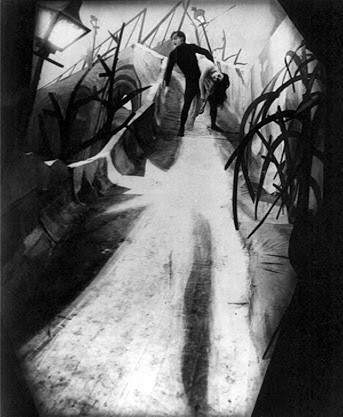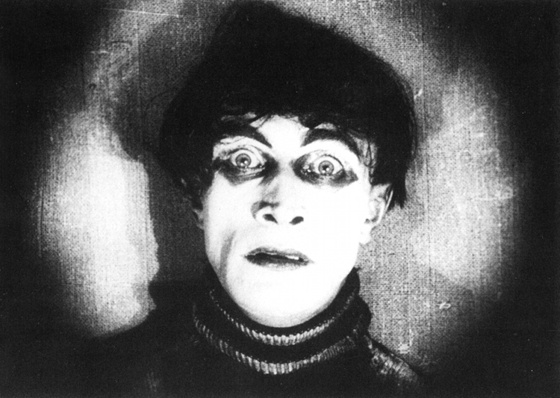
German Expressionism was born at a tumultuous time in German history. Despite the chaotic period, it produced a distinct style. The movement rushed in new storytelling methods, themes, and stylistic techniques. The iconic films of this movement were Das cabinet des Dr. Caligari (The Cabinet of Dr. Caligari, Robert Weine, 1920) and Der letzte Mann (The Last Laugh, F.W. Murnau, 1924). Both dealt with the fracturing of reality, which reflected the paradoxical nature of Germany’s identity. Identity was a significant issue that German filmmakers tried to grapple with. For analysis, it is best to view German Expressionism through an aesthetic lens while keeping in mind the social and economic context.

After the loss of the first world war, class consciousness was on the rise due to staggering income inequality, poverty, and inflation, plus there was nationalistic ideology being propped up by the Nazi party.[i] While Germany’s political and economic situation restabilized after the early 1920s, it would only last a couple of years, and the prior inflation had already taken a toll on the middle and lower classes.[ii] This was the German landscape, and the film movement was born out of this crisis. German identity was in contention. On the one hand, there was the cynical reality of Germany’s hardships on the proletariat. On the other, an idealized Germany was being propped up by Nazis. The new, uncertain republic was stalked by a shadow of its former self, a mighty empire. Even Germany’s cinema industry seemed contradictory as it had expanded the most during the worst economic and political upheaval. [iii] Not only this, but also there is a nationalistic undertone for the film movement to be dubbed German Expressionism. Yet, the movement is critical and cynical of Germany. It is essential to note how strained German identity was because the movement drew from these social and economic conflicts and communicated them through its aesthetic.
The fractured identity of Germany was represented in this film movement as the fracturing of reality. The objective truths represent reality, while hallucinations or mental and emotional instability represent nonreality. The style weaved reality and nonreality into the mise-en-scene. The set design of the films was dreary and often reflected the mental state of their characters. Films with painted backgrounds used blacks, greys, and whites, which mimicked Expressionist paintings.[iv] The set’s lighting added to the distortion of the film. The use of bright light would show the contrasting blacks and greys, while the use of faint light emphasized the film’s darkness. Also, actors performed exaggerated movements to highlight their bodies and show that they were part of the mise-en-scene.[v] The style’s surrealistic nature could be distilled into the phrase a “hallucination that is also a fact.”[vi]

However, the Expressionist movement truly stamped its mark in camerawork and editing. The filmmakers used camerawork and editing to demonstrate relationships between actors and their environment. For camerawork, the filmmakers experimented with techniques and the “unfastened camera.”[vii] The camera could move around, linger, watch over, or circle around the characters and move farther away or closer. One shining example was the use of close-up shots to show the actor’s expressions.[viii] This technique was an advantage in the silent film era and for the Expressionist purpose. It gave more insight into the character, especially their emotions and mental stability. While the use of close-up shots gave a level of intimacy of the character and their mental state, the close-up shots also contrasted with landscape shots where the character is part of the background. As for editing, filmmakers would superimpose images and crosscut to create distortions.[ix] In particular, superimposed images could be used for a hallucination sequence and demonstrate the instability of a character’s mind. Filmmakers also heavily used shot/reverse shots to establish a narrative relationship and an emotional or symbolic connection.[x] With the use of camerawork and editing, the already established surrealistic style is enhanced.

Again, this movement focused on the fractured identity of Germany which seemed contradictory: capitalism vs. socialism, bourgeoisie vs. proletariat, nationalism vs. cynicism.[xi] The paradox manifested in the fracturing of reality. With distortion interwoven into the narrative and the screen, one cannot always see where reality ends and nonreality begins. Even in scenes where reality and nonreality are apparent, they are both present. Consequently, their co-existence creates the surreal. Thus, the paradox is surreal and by highlighting the surreal, it invokes one to point at its absurdity. After all, how can two opposing concepts co-exist as one? While it can’t exist fully together, it can exist fractured together. Surrealism allows for reality and nonreality to be joined like pieces in a puzzle. In relation to Germany’s identity, its contradictory qualities can exist because Germany is not being presented as a unified self. Instead, Germany’s identity is akin to a puzzle.

The catalyst movie, The Cabinet of Dr. Caligari, and an equally iconic film, The Last Laugh, directly dealt with reality and nonreality which combined to create a surrealism. Wiene set the foundation for the aesthetic of the movement by painting and distorting the scenery and by dressing the actors to look like part of the painting.[xii] Murder and a phantom loom over the German town whose architecture is twisted and wicked. The movie ends with the delusional state of Dr. Caligari, whose reality is fractured by his mental instability. Murnau’s The Last Laugh also dealt with the descent into mental decline and its effects on a character. While it was set in actual buildings, the emphasis on lighting had the same dark, twisted effect. The doorman slowly has reality distorted as his mental state worsens due to his job loss. His financial troubles drive him into worse situations that lead into madness. Reality and hallucination become muddled, leaving him and the audience to question what is real and hallucination. While both films do not point to politics directly, the fracturing of the fictional worlds are meant to mimic the internal turmoil of German identity.
Ultimately, its distinct flavor cannot be overstated, and the techniques used within this movement were groundbreaking. The filmmakers combined elements of reality and nonreality which made their films surreal and symbolically represent the paradox of Germany’s identity. The filmmaking pulse in this movement may have died in Germany with the rise of the Nazis, but its legacy remains.

Kai Walker is a University of North Georgia graduate who majored in Interdisciplinary Studies.
[i] “Germany from 1918 to 1945.” Encyclopædia Britannica. www.britannica.com/place/Germany/Germany-from-1918-to-1945.
[ii] Ibid.
[iii] Thompson, Kristin and David Bordwell. 2019. “Chapter 5: Germany in the 1920s.” In Film History: An Introduction, 86-102. McGraw-Hill Education. 86.
[iv] Ibid, 89.
[v] Ibid, 90.
[vi] Bazin, André, and Hugh Gray. “The Ontology of the Photographic Image.” Film Quarterly 13, no. 4 (1960): 4–9. https://doi.org/10.2307/1210183.
[vii] Thompson, 96.
[viii] Kurtz, Rudolf. 2016. Expressionism and Film. John Libbey Publishing. EBSCOhost. search.ebscohost.com/login.aspx?direct=true&AuthType=ip,shib&db=e000xna&AN=110668&site=ehost-live. 58.
[ix] Ibid, 60. And Thompson, 92.
[x] Thompson, 92.
[xi] “Germany from 1918 to 1945.”
[xii] Kurtz, 64.
